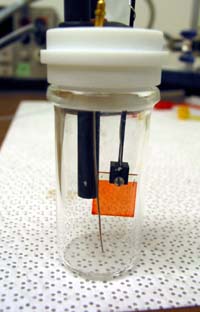|
Facilities and Methods

Facilities
Our lab currently offers the following instrumentation
and apparatus:
- Nitrogen glovebox with spinner and thermal evaporator
- Oxford Maglab cryostat
- Confocal Optical Microscope
- Ocean Optics UV/Vis Dual Grating Spectrometer
- Park Scientific Autoprobe CP Scanning Probe Microscope
- n&k analyzer for optical analysis of thin films
- several GPIB programmable measurement and power supply
units
- Nicolet Digital Scope
- SRI Lock In Amplifier
- Velonex high power pulse generator
- EG&G Model 362 scanning potentiostat
- PerkinElmer LS 45 luminescence spectrometer
|

Cyclic Voltammetry |
Methods
The experimental methods employed are:
- Current/radiance vs voltage curves to characterize polymer
LEDs for their performance (brightness, quantum efficiency...)
and for the underlying physics. Temperature dependance is studied
using a cryostat. Radiance (W/cm2) is measured with
a Si-photodiode that has been calibrated with an integrating
sphere and a calibrated halogen lamp.
- Emissionspectra analysis and CIE color coordinates calculation
- Photovoltaic measurements with a Xenon lamp
- Transport studies and 1/f noise analysis at the metal insulator
transition of carbon black polymer composites are studied using
the cryostat.
- The Scanning Probe Microscope allows surface characterization
and imaging down to the nanometer scale in different operation
modes (Atomic Force-, Noncontact- , Scanning Tunneling-Mode)
- Photoluminescence studies with the confocal optical microscope
with micrometer resolution
- Optical analysis of thin films yields determination of film
thicknesses by measuring reflectivity- and transmission-spectra
- Lifetime studies with automated setup
- Impedance spectroscopy for the determination of capacitance
vs bias curves and equivalent circuit models of polymer devices
- Photoluminescence measurements for liquid and film using a
PerkinElmer LS 45 luminescence spectrometer for optical
characterization
- Cyclic voltammetry for the electrochemical characterization
of materials using an EG&G Model 362 scanning potentiostat
and BAS low-volume electrochemical cell setup.
|
|